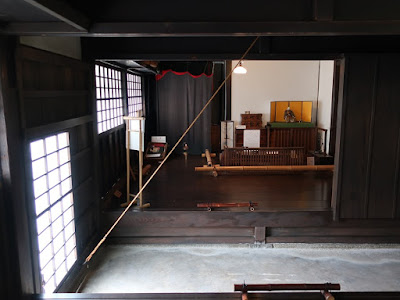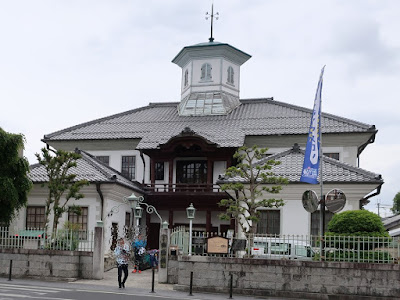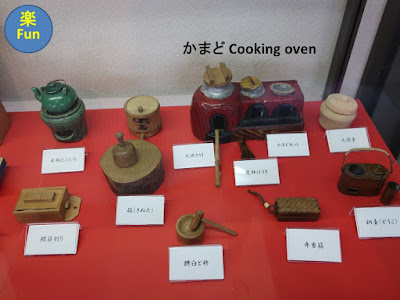Ohmi-Hachiman is a home town of entrepreneurs, especially in the Edo and Meiji period. There is an old building district and a moat, which are popular among the travelers. There are three city-run museums here. I was impressed by the elaborate girls’ toy which educates them.
 |
Three museums are on the Shin-machi street
which is designated as a traditional building conservation district.
新町通り(重要伝統的建造物群保存地区)に三つの資料館が並んでいる。
|
江戸・明治に多くの商人を輩出した近江八幡は、古い町並みとお堀で人気の観光地なっている。市立の資料館が三館ある。旧西川家住宅に展示されていた、ままごと道具が素晴らしく精緻にできている。良家の子女は、これを使って道具の名前や用途を覚えるらしい。
Former Nishikawa Family Residence 旧西川家住宅
 |
This Kyoto-taste merchant house was built
in 1706.
1706年に建てられた京風の商家。
|
 |
The kitchen door (backdoor) is the
entrance of this museum. Many Gogatsu(May)-dolls for the Boys’ Day were exhibited.
勝手口が資料館の入り口。玄関を望む。たくさんの五月人形が展示されていた。
|
 |
The corridor to the main entrance. The
noren (shop-curtain) is hung in which the crest of this shop was dyed.
玄関に続く廊下。暖簾には「大文字屋」の紋がある。
|
 |
The front door is not so big, and it is
opened by slinging. The counterweight is equipped to sling easily.
店の玄関は意外と小さい。跳ね上げ戸になっている。錘のついた綱で吊り上げる。奥は帳場。
|
 |
Mosquito net covers the bed to guard
people from mosquitos. It brought wealth to Nishikawa family which is a
well-known company of bedding now.
蚊帳や畳表が西川家が扱って財をなした商品。ふとんの西川のビジネス源流だ。
|
Toys for girls、ままごと道具
 |
The kitchen-ware set including running
water.
台所道具。水道があり、明治以降のもの
|
 |
Douko is used to boil water or to warm
sake (alcohol)
湯を沸かしたりお酒を温める銅壺(どうこ)
|
 |
| Miniature tea party set、お茶の道具もミニチュア |
 |
| Tableware and trays、お膳と食器類 |
 |
Palanquin(upper left), account ledgers(lower
left), chest etc. I think this is a similar culture with SylvanianFamilies. (https://www.sylvanianfamilies.com/ja-jp/)
駕籠やタンス、大福帳もミニチュアだ。シルバニアと同じ楽しみだ。
|
都から少し(40km)離れたところでも、雅な暮らしを想像して楽しんでいたのだと思う。
Makeup set、化粧道具
 |
This lacquer ware is not miniature. From
right, the mirror in the case, its stand, box of combs.
こちらは大人用の江戸後期の化粧用具。櫛台(化粧箱)と鏡箱、鏡掛け台
|
 |
Mobile makeup set which was made around
1900. Many tools in it.
この携帯用化粧箱は逸品。明治から大正期のもの。刷毛まで入っている。
|
 |
(Mobile combs, they are beautiful.
道具が美しい。大正期の携帯用整髪具
|
“Exhibition of the Boys’ Day dolls” owned by merchant families in Hachiman、八幡商家に伝わる「端午の節句飾り」展
 |
Luxurious dolls are exhibited. We
celebrate boys’ growth and display samurai dolls on the 5th of May
which is a national holiday.
立派な五月人形が飾られている。家族みんなでお祝いだ。
|
 |
Balls and lantern, these aren't luxurious
but cute.
ちょっとした鞠と照明だが、可愛らしい。
|
 |
| It is a really big house. 座敷だらけだ |
 |
| The garden is not huge. 庭は普通かな。 |
Local Museum、郷土資料館
The old structure of this town, an innovative water supply system in
the medieval era etc. are exhibited.
It is written on the poster, “Merchants from Hachiman, who
had shops in Edo (old name of Tokyo) or Osaka, invited employees from their
home town, because they were reliable.
By the way, the representative of the Korean court visited Hachiman
during the Edo period (1603—1868). They walked from Nagasaki to Edo, but they
didn’t walk on the major highway called Nakasendou partially. They walked near
the Lake Biwa and went through Hachiman. The road is called Korean
kaidou(highway). I think the view of the lake and the residents entertained the
representative, which was very attractive procession for Japanese because of outfits
and manners.
Photography is prohibited in the exhibition
room. |
Exhibition room of the 1st floor (photo of
the brochure)
一階展示室(パンフレットから)
|
八幡には、信長が倒れて安土城が焼けた後、城が築かれ、安土から住民が引っ越してきたという。街割や、古式水道が展示されている。
江戸や大阪に店を開いた八幡商人が、信頼できる八幡の人を雇ったことなども書かれていた。また、朝鮮通信使は、中山道を離れ、八幡と彦根を経由してまた中山道に戻ったという。この42kmが朝鮮人街道と呼ばれている。風光明媚な湖岸を楽しんだのだろう。
館内は撮影禁止。Museum of History and Folklore、歴史民俗資料館
 |
Daily utensils are shown here. The
building was a merchant house. The entrance is same as the Local Museum above. Photography
is prohibited in some areas.
民具が展示されている。元々は商家である。郷土資料館から入る。撮影禁止の表示が所々にある
|
 | |
| It’s also excellent house. こちらも立派な商家だ |
Sagicho Museum (culture tradition house)、文化伝承館
 |
Sagicho festival is introduced in this
small building which is next to the Local Museum.
郷土資料館の隣の小さな建物では「左義長まつり」の様子が展示されている
|
 |
The floats parade around the town in the mid-March.
三月半ばに、町内を練り歩く。
|
 |
The “Dashi” centerpiece is set on the Sagicho
float.
左義長の中心に置かれる「ダシ」の飾り付け
|
 |
In the early 20th century, it
was a fancy-dress parade!
昭和初期の左義長。仮装行列だ。
|
MENTURUM Museum、メンターム資料館
“MENTURUM” is a famous skin-care brand in Japan. The HQ is still in Hachima, and this is the company museum which introduces the products and the history. Unfortunately, it was closed because of Saturday.
メンタームでおなじみの近江兄弟社の資料館もある。この日は土曜日で休み。製品や歴史が紹介されている。
Tourist spots in Ohmi-Hachiman city
 |
Hachiman Moat cruising attracts many tourists. The boat
moves slowly.
すっかり人気になった八幡堀めぐり。ゆっくりと進む。
|
 |
Himure-hachimangu Shrine which Sagicho
floats are offered to、左義長が奉納される日牟禮八幡宮
|
 |
“Hakuun(white cloud)-kan(building)”, which
is in front od the shrine, was built in 1877 as a school, it is a tourist
information center now.
明治10年に学校として建設された白雲館は、観光案内所として活用されている
|
La Collina (Ohimi-Hachiman)、ラ コリーナ近江八幡
It is a site of sweet company “Taneya” which has factories, shops and cafes. This is the really major tourist attraction here. The concept of this site is amazing and there is a charged site tour.
お菓子工場&直売所と思うと大違い。外国のようです。Must Go!です。
 |
Sweets are made and sold in the same space,
so we can buy fresh products. 作りたてを購入できる。
|
 | |
| Bathroom is also sophisticated. トイレも素敵だ |
Ten funs(楽fun)were found. Visited in May, 2019
Website of the museums : http://www.city.omihachiman.shiga.jp/contents_detail.php?frmId=45 (in Japanese), accessed in March, 2020
Previous post (Museums in Kyoto, which is a tea production area):
Museums in Uji, Kyoto 宇治の資料館
Next post (Museums in the same region、同じく近江商人の街):
Museums in Ohmi Gokasho (1)、近江・五個荘の資料館(1)
















Comments
Post a Comment